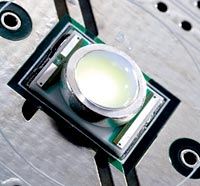Greg Merritt of Cree Inc. was the featured speaker when Progress Energy hosted a “Lunch and Learn” session on Aug. 15. Cree, a North Carolina-based high-tech manufacturer, is an industry leader in development of LED lighting and a co-creator of the LED City program. The company only sells to other manufacturers who produce lighting products, so Merritt wasn’t selling anything, per se. Representatives from some 50 local businesses and institutions had signed up for the session, and their I.D. tags bore familiar names: Asheville Schools, Asheville Regional Airport, Biltmore Farms, Colbond, Haywood Regional, Haywood County Medical Center, Holiday Inn, Mission Hospitals, Sutton Kennedy and UNCA were among those represented.

Light-emitting diodes are solid-state electronic devices that efficiently convert electric current to visible light. They use far less electricity than incandescent or fluorescent lights and result in no toxic waste when discarded. (Fluorescent bulbs contain mercury, which means that used bulbs are hazardous waste.)
The first LEDs, invented by General Electric in 1970, were dim red dots that made their first consumer-market appearance as indicator lights on stereos. By 1990, bright red, orange, yellow and green LEDs had been developed, and now they’ve become the standard for traffic lights. In 1989, Cree developed the first blue LED—an important milestone, because without blue light it isn’t possible to create the bright whites necessary for area illumination. Soon the brighter LEDs found application in Las Vegas casino marquees, taillights and light bars on emergency vehicles. “Now you can’t get a ticket without an LED being involved,” Merritt observed, “and LEDs have swept the flashlight market.”
In the past year, Merritt said, LEDs have moved into the mainstream through the LED City program in Raleigh. “In partnership with Cree, the city of Raleigh evaluated the potential for LED lighting across its entire infrastructure: parking garages, parking lots, street lights, pedestrian lights, offices, portable lighting and swimming pools,” he explained. They chose a parking deck behind city hall for the first application. After replacing the old high-pressure sodium lights with LED fixtures, energy use was reduced by more than 40 percent, according to an independent analysis done for the city. Not only was the facility brighter, but a survey of garage users found that 75 percent felt the it was safer as well. “And those are two-generation-old LEDs,” Merritt noted. “Our newest model is brighter will save 80 percent of the original energy use.”
Merritt said that large-area commercial applications were the fiscal starting point due to energy-and-maintenance savings, as well as the cool color quality of the first generation of white LEDs. A breakthrough in warm white LED manufacturing last spring will make its market debut late this year, he said. Warm whites are preferred for home and office interior lighting because they mimic sunlight, which humans are biologically adapted to use best.
“Just as the CD has replaced the phonograph record and the memory stick has replaced photographic film, the LED is the next step in the digital revolution,” he predicted. “The incandescent bulb is the last application of the vacuum tube, and your grandchildren won’t know what you mean if you say ‘light bulb.’”


Before you comment
The comments section is here to provide a platform for civil dialogue on the issues we face together as a local community. Xpress is committed to offering this platform for all voices, but when the tone of the discussion gets nasty or strays off topic, we believe many people choose not to participate. Xpress editors are determined to moderate comments to ensure a constructive interchange is maintained. All comments judged not to be in keeping with the spirit of civil discourse will be removed and repeat violators will be banned. See here for our terms of service. Thank you for being part of this effort to promote respectful discussion.